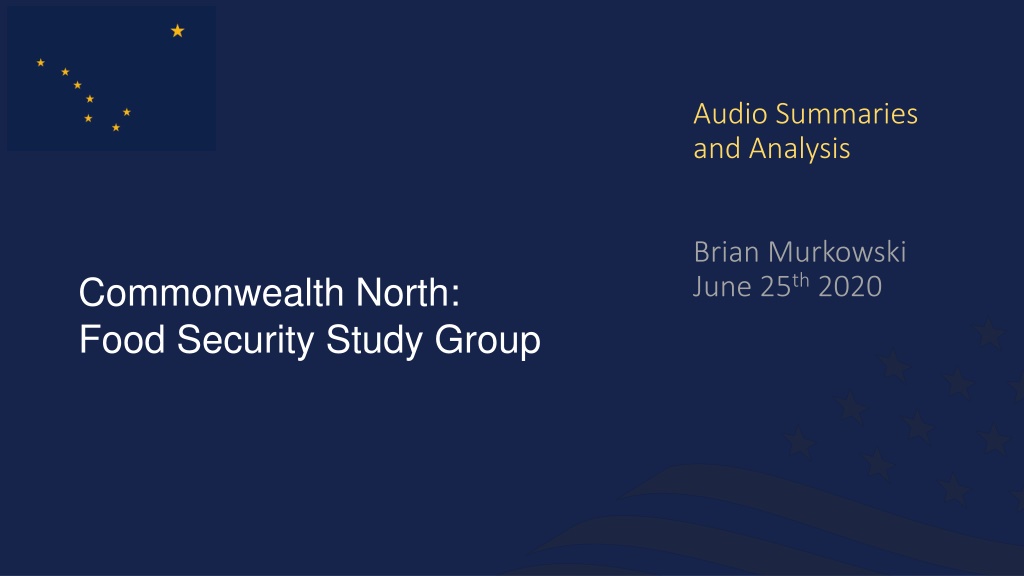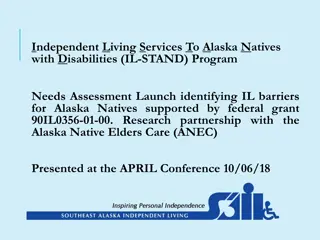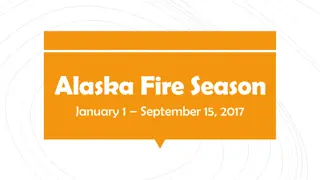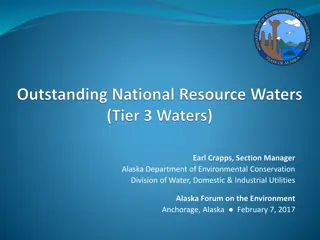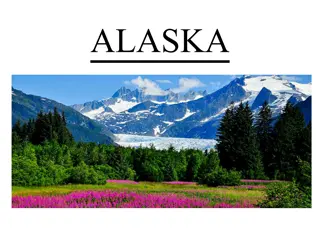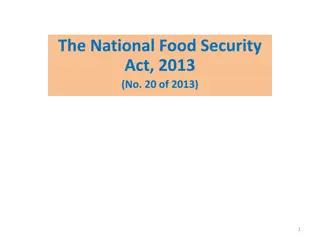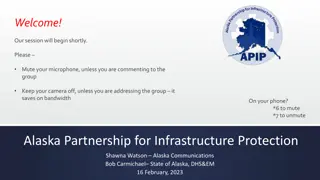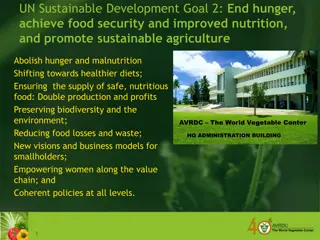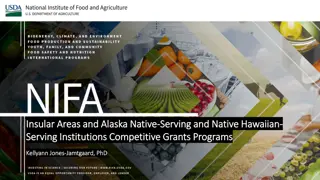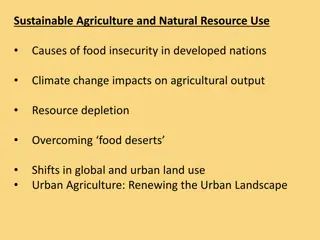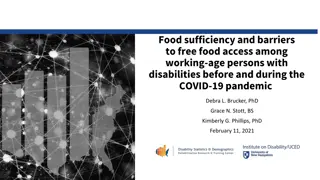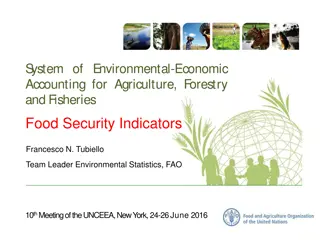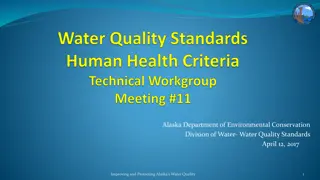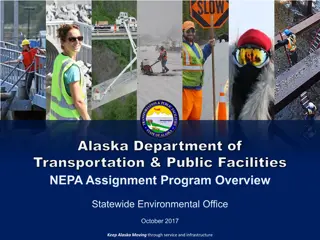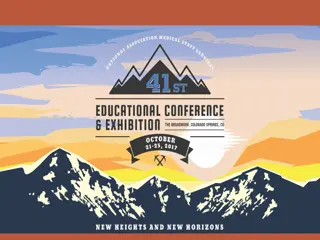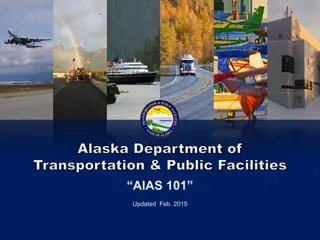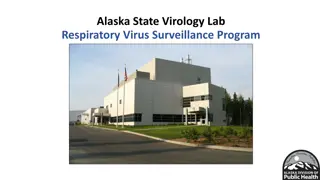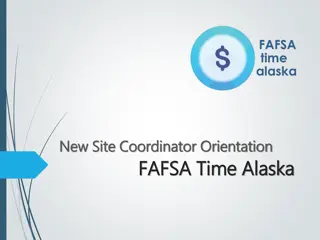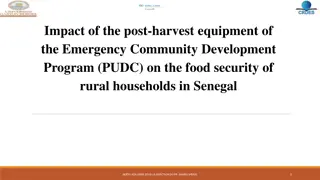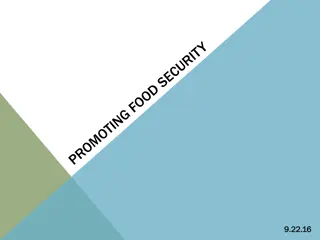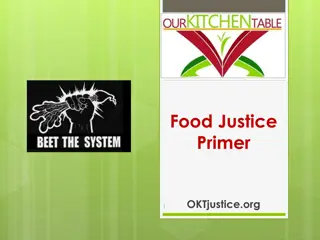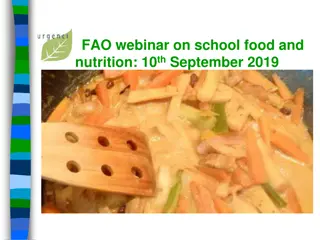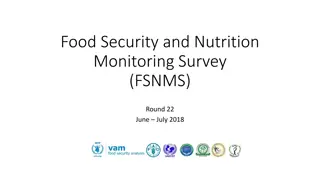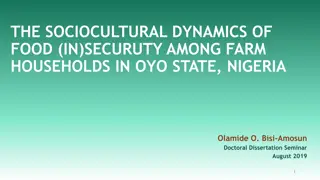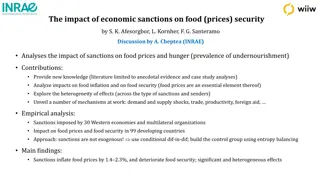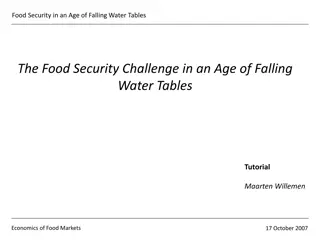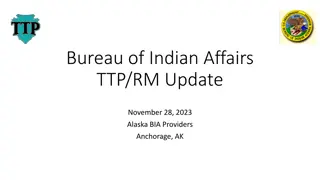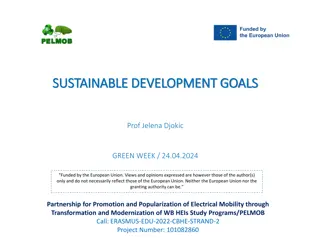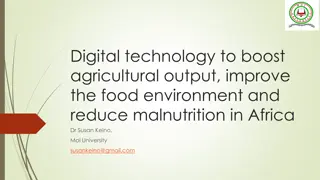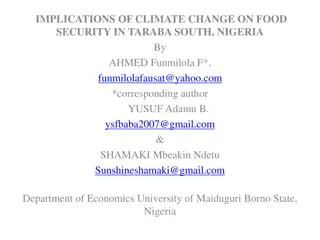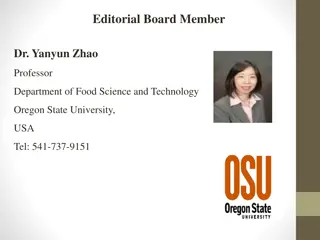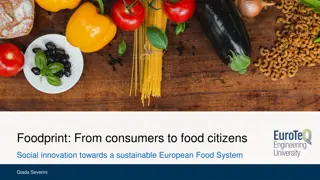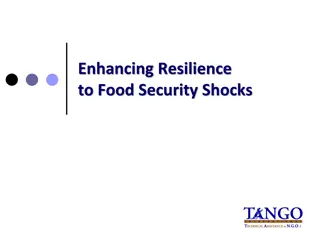Food Security Study Group in Alaska: Strategies for Sustainable Programs
This study aims to identify actionable strategies for Alaska businesses to benefit from local food sources, develop a network of stakeholders promoting food security, implement risk reduction policies, and enhance sustainable programs. Key areas include defining food security, legislative requirements, stakeholder roles, and disaster preparedness.
Download Presentation

Please find below an Image/Link to download the presentation.
The content on the website is provided AS IS for your information and personal use only. It may not be sold, licensed, or shared on other websites without obtaining consent from the author. Download presentation by click this link. If you encounter any issues during the download, it is possible that the publisher has removed the file from their server.
E N D
Presentation Transcript
Audio Summaries and Analysis Brian Murkowski June 25th 2020 Commonwealth North: Food Security Study Group
Title Table of Contents Table of Contents Measure of Success Scope of Study Key Questions? Amy Sykes - AK Farm Bureau Amy Petit - AK Farmland Trust Eve Van Dommelen Food Bank AK Karen McCarthy Sen Murkowski Rachael Miller Food policy Council David Schade AK Div of Agriculture Tom Harris/ Charles parker AK Village Initiatives Aqualogic/Gueck, 3 Bears Charles Parker AK Village Initiatives Rick Green AK Dept of Fish & game
The Study will succeed in 4 ways: 1. Identify actionable strategies that enable Alaska businesses to belter communicate and benefit from the availability of local food Measure of Success 2. Develop a network of action-oriented stakeholders who will promote food security after recommendations are completed 3. Implement risk reduction policies and procedures for food supply disruptions 4. Enhance the states ability to develop sustainable programs and resources for food
Develop key definitions around the topic of food security for Alaska and its communities Develop Suggest initial metrics or methods to communicate risk to food security and track incremental improvements to it Suggest Scope of Study Use past research and information provided to CWN: AK Division of AG, Homeland Security and DNR; the U of A; Alaska Village Initiatives: etc Use Identify and track local, state & federal programs Alaskans can use to reduce food security and create long term sustainable program through, eg: Microgrants New staffing opportunities for agriculture jobs and grants Identify and track
What is food security and how does the state and other organizations define it for for: Its urban residents Its rural residents Some Key Questions to be Addressed What basic legislation, infrastructure and resources are required to maximize and optimize agricultural/game capacity in the State? What are the federal, local and state s role in food security and how can the state help coordinate and stimulate sustainable demand? What are the state s contingencies in the event of a natural disaster or distribution at the Port of Alaska? Others .
Amy Sykes, Dir. AK Farm Bureau: Amy Sykes, AK Director for the Alaska Farm Bureau, Div of Agriculture. They act as advocates to build and improve agriculture economics and create a strong industry for the benefit of all. They promote Ag policy, education, and food security. The Dept of Ag's definition of Food Security involves "making sure that residents have access to food in an emergency" Food Security should mean a 90 day supply. The CDC says 90 days is necessary in the event of a major bio-hazard release etc. The table below shows how much food might be needed in Alaska for 90 days. Farm Bureau focuses on: Policy: Land, Access, sustainability Regulatory: Access to capital, processing Capital: eg. ARL Agriculture Revolving Loan Infrastructure: transport, storage, processing Education and Awareness: eg 4H, UA system, Land grant university Markets: Analyzing where products need to go based on need and economics
Amy Sykes, Dir. AK Farm Bureau Amy emphasized the need to maintain good farming opportunities by conserving the land, making more land available to farm, helping farmers sell to other farmers rather than to developers, setting aside future tillable land. Alaska does not have a great deal of suitable ag lands so what we have needs to be conserved. She said the role of the State should be to enforce rules to keep farms in production with the demand on property taxes. She said many "Alaska Grown" products are sold at a premium by grocers, not a less expensive option. She said the rail extension at Port Mackenzie was one area the state could make a positive impact as the rail could connect Delta with the rest of the state via rail. The rail can reduce shipping costs and the movement of livestock costs. One of the biggest challenges for encouraging local growers is economics and the small population size is challenged in supporting it. Programs like ALRF can be ill-suited for Alaska as we are a brand new agricultural area while most of the laws are designed for mature regions in the lower 48. It's capped at $250,000, 10 years of prior farming experience, established in '70s now outdated. Amy says she receives abut 4 inquiries a week on from programs. The budget is small with almost no travel budget. UAF was established as an agriculture and mining uni but it has strayed from its agricultural roots and perhaps has not done enough to manage its lands efficiently as a land grant institution. Alaska is different and needs to be treated as such. For instance, we have no egg inspection so growers cannot get insurance. Small Farm exemptions are needed. We are 100 years behind and programs are not designed for our needs. The Feds need to change the laws for Alaska's ag industry to have a chance. The Farm Bureau does not manage wildlife.
Amy Petit: Alaska Farmland Trust Terry began by mentioning the mandate from the Board to be inclusive: Should we separate the issue On-Road vs Off-Road? What is the basic definition? We have so many constituencies but each needs to be looked at uniquely. What is the USDA definition? Do we use it and if not why? Not all calories are the same. The quality of calories in rural markets is poor compared to subsistence, natural alternatives. We need to produce more locally to be self-sufficient and provide food security but that is difficult because demand is small, costs are high, logistics challenging. We need to be focused worst-case scenarios...mid winter crisis when subsistence is not practical for most and game scarce. How long will disaster response time be? What time frame could the military or international aid arrive? And this doesn't factor in a possible war scenario where outside supply disruptions could last for an unforeseen period of time. Cheet-o calories are not the same as moose or salmon calories. The discussion ranged into the Charter of The Forest. What fundamental rights do we have as Alaskans both native and non-native to utilize their resources? should we proactively manage them like they do in the lower 48? it's not a rural-urban thing its a fundamental right. Should we bring fish and wildlife under the control of the Dept of Ag? The first priority of wildlife should be for personal use for Alaska residents. We have 6 different game/ecosystems in the State so not all people would necessarily have access to the same game or the amount of game.
Amy Petit: Alaska Farmland Trust Cont. The USDA definition is not a caloric one. All (Alaskans) should at all times, have access to foods to live for a healthy active life-1992 action plan, food safety statement How do we define Food Safety with context? calorie-wise or some other way? The Canadian government mismanaged its salmon fisheries to the point that there is no subsistence fish available in numbers to meaningfully contribute to a caloric base. Is food security 2000 calories per day or is it that Alaskans can self produce adequate food in winter and persevere for a sustained period with little outside assistance? the Short and long term requirements are different. If you can't make it economic, it's not sustainable. We need to develop a national and international market for our goods so that we have more than we need and can share but then in the event of a crisis we would be able to self sustain. We need infrastructure like warehouses and hydroponic, indoor tunnel farming. Short Term is not as worrisome...the military or other outside aid should be able to make it. Its the medium and long term that are concerning until we develop ag viability into the entire state. As an example, how can we manage fish and game for more production? How do we integrate the two worlds of traditional and non-traditional, urban and rural ways of life and food security with one another? In other states, wildlife is managed for-profit and it largely works. Perhaps managing more of our game for profit would change the equation.
Amy Petit: Alaska Farmland Trust The goal of the Alaska Farmland Trust is to secure farmland for future use, educate, develop infrastructure, and to assist in marketing. but the big 3 are secure, promote, educate. they have secured 315 acres, 6 parcels, 75 acres under contract, and applications for another 300 acres. They do not own the land but they own the development rights. They step in to help farmers sell their land to other farmers at fair market rates. Typically a large developer will pay huge sums for farmland that other farmers cannot pay to acquire so they can help bring state and federal loans/grants to help farmers keep cultivating. The goal is no net loss on agricultural lands in Alaska. For as large as the state is, it lands suitable for farming are a very small percentage. One of their objectives is to remind people of Alaska's agricultural successes like the peony's rather than the few failures, such as the Delta Grain silos, which typically garner the most attention. Alaska is #1 in new farmers. our farmer's markets have been growing exponentially with $2.2MM in sales in 2012 vs $4.5MM in 2017. Alaska Farmland Trust's definition of Food security is: When all in Alaska have access to local, healthy, and affordable food. The government's role should be to help organizations that promote agriculture, support champions, perhaps privatize the logo, monitoring etc. We need state government to match federal funds. The short-term strategy is to protect farmland that can grow food. Alaska land is not particularly good, and logistics are bad making the preservation of farmlands, particularly nearer to towns and cities, their priority. Public policy recommendations include support for agencies that help the agricultural sector and don't curtail programs designed to help. Remove barriers to new farmers and farmland.
Eve Van Dommelen Food bank of Alaska, Policy and Advocacy Manager The FBA is a statewide organization responsible for the distribution of food, SNAP outreach, and policy advocacy. Outline for presentation: Framing Food Security/Insecurity Food Security in Alaska Federal Policy and Advocacy State Policy and Advocacy SNAP FINI Grant Useful Reports Policy Recommendations Framing Food Security: You need to discuss from many different perspectives Foodbank continuum: Direct distribution, connect clients to services, advocacy and education, SNAP outreach Food security solutions: efficiency, S/T relief, substitution, capacity building, redesign strategies The USDA describes Food InSecurity as: "Lack of consistent access to food for an active, healthy life".But in Alaska it also has 3 other levels: Local cultivation of agriculture and preparedness (3-5 day supply) Subsistence: Native issues, enviro issues, mixed markets, AK identity Poverty & Econ Insecurity: High COLA, diverse needs, differing infrastructure to handle poverty, barriers to basic needs
Eve Van Dommelen Food bank of Alaska, Policy and Advocacy Manager Cont. Alaska Hunger Stats: 1/7 Alaskans face Food Insecurity (~107,000) 1/5 Alaska kids live in homes that may not have enough food ~155,000 Alaskans access the Alaska Anti- Hunger Network Annually 60% of clients served at FBA and partner agencies worked for pay in the last 12 months 56% choose between paying for food or medical care 53% choose between food and housing 64% between food and transportation 59% between food and utilities Many face the econ decisions of Food vs mortgage, food vs transport, food vs heat; Food security has been shown to reduce crime, improve education, etc Federal Policy advocacy: Over the last 2 years, much of their effort was focused on failed Farm Bill. The delegation provided support, but Bill stalled. One aspect, the Nutrition Title, kept it from passing. It is important because many of the Programs fall under its purview. eg work requirements for SNAP that may discourage folks from getting off the program by increasing their income. It is hard to monitor in Alaska due to our barter economy, and unique and seasonal work environs. The Emergency Food Assistance Program: Strongest program for getting food into the community. But in rural Alaska for example its only commodity goods, not typically produce, due to cost, logistics, time etc. Senior Box Program, Summer food Program, School Lunch Program all fall under the EFAP. Very important to Alaska State Policy advocacy: 2019 budget cuts did not hit the food bank too hard but the cuts elsewhere to the economy have created more in need, so the need for more state help has increased. The State has been maintaining programs for young and old but due to paperwork problems and bureaucracy, many of these are hard to implement and offer.
Eve Van Dommelen Food bank of Alaska, Policy and Advocacy Manager Cont. Priorities will be SNAP. it is the #`1 defense for food security for many Alaskans. SNAP provides 12 times the food the Foodbank provides, about 6 million meals in Alaska. It provides food for 85,000 Alaskans per month. In rural Alaska, SNAP keeps grocery stores open. The multiplier effect is 1.75:1. In a typical month in 2018, SNAP helped an average of 85,111 Alaskans 20% of Alaska s Children rely on SNAP SNAP eases the burden on the anti- hunger network in Alaska, as well as individuals trying to meet their basic needs. SNAP is an incredible economic stimulator every $5 of federal SNAP benefits generate nearly $9 in local economic activity. In 2018, SNAP benefits pumped about $175 million into Alaska s economy Some SNAP Facts: SNAP & Local Ag: SNAP is available at some farmers markets Senior Farmers Market Nutrition Program Limitations In order to receive SNAP, income must be low. They would like to create a transition so that folks don't have to take a huge hit as they move off the program SNAP is available at some Farmer's Markets but there are problems with the EBT cards. Some Markets can exchange credits for tokens that can be used. Need more updates on this.
Eve Van Dommelen Food bank of Alaska, Policy and Advocacy Manager Cont. FINI Grants 2019 Updates: Gus Schumacher Nutrition Incentive Program (GusNIP), Produce Prescription, Nutrition Incentive Program Training GusNIP is essentially a SNAP double-bucks program FBA to apply for a GusNIPGrant collaboratively with other organizations in 2020 GusNIP requires a 50% match FBA will apply for GUSNIP grant collaborating with other organizations in 2020. need State help to match. They are looking at IN-Kind match as an alternative. Useful Reports: Map the Meal Gap, 2019 Hunger in America Study, Alaska Report (2014) The Importance of Local Foods in Mitigating PovertyRelated Food Insecurity (report on rural hunger in Alaska), Burke & Durr We are in the beginning stages of planning a Hunger in Alaska Study for Fall 19/Spring 20 Policy Recommendations: Ask Alaska State Legislature to match FINI Grant funds FBA and partners plan to apply collaboratively for a GusNIP grant in June of 2020. Matching funds from the legislature would not only make this grant possible but also show that the legislature supports Alaskans struggling with food insecurity. The GusNIP grant has the potential to have a co-benefit of being able to support local agriculture through increasing the capacity of low-income Alaskans to buy Alaska-grown produce. Support increase to the SNAP asset limit/transitional benefits this policy ask would help support low-income Alaskans as they move towards self- sufficiency. Rather than losing necessary benefits as they gain better employment and wages this would allow Alaskans to transition more slowly off of benefits allowing them to save money for future extenuating circumstances Maximize Federal Funds for Nutrition Programs not only does this support low-income Alaskans, this supports Alaskan communities that can benefit from increased Federal dollars being pumped into local economies and infrastructure. Generally, the legislature has been positive and supportive. They are always seeking champions. Terry, Pres of CWN asks: What is the broad policy we are creating? How can we focus the legislature on the bigger picture? What is the mandate? For instance, is it the caloric minimum from FDA? How is the State set up to serve the people in a crisis? How do we sustain us, both on and off the road system? we are getting many L/T ideas what are our S/T solutions? Charles: We are focusing on cities but missing rural AK. We are missing out on managing our resources for our own emergencies. Food security in AK is a lot about subsistence, not just for natives but for everyone, we all have a fundamental right to eat and subsist but are we managing our resources to that end properly?
Rachael Miller: Assoc Prof APU & AK Food Policy Council Ed Fogles began: We need to take all the recommendations and figure out where CWN can make a difference. Let's keep track of our action items and recommendations. Rachel Miller: An Assoc Prof at APU who also works with the Alaska Food Policy Council Everyone is for food security, the question is how to implement it and develop a policy that works for Alaska. AK Food Policy Council (AFPC) est in 2011 with the goal to "create a healthier, more secure, and more self-reliant Alaska by improving our food system. Food systems are actually like a food web with many moving parts inputs and variables that can help identify inefficiencies and waste in the system, whether in logistics, fertilizer costs, market demand etc. Food System Elements can differ depending on perspective. the Inupiat Food System includes Food Sovereignty or subsistence which other systems do not. Food sovereignty is a critical piece of the conversation here in Alaska. 2014 was the last major study that was commissioned by the Dept of Ag. It is being updated and new information will be released in Sept 2019. The study found that Alaskans spend $1.9bn on food produced outside Alaska. $ flowing out of the state. Direct sales to consumers rose 32% from 2007-12 and now have run at 13 times the national average. The value of food sold to consumers increased from $2.2mm in 2012 to $4.5MM in 2017.
Rachael Miller: Assoc Prof APU & AK Food Policy Council Cont. 2014 Meter Report recommendations: Foster Subsistence Harvesting and Related Skills, Build Personal Capacities in Agriculture Expand Agricultural Production and Gardening Build Infrastructure that Supports Local Food Production Adopt State Policy that Supports Local Food Production Focus Consumer Attention on Staying Loyal to Alaska Grown Food Expand food processing and manufacturing for in-state markets Strengthen internal food distribution networks Strengthen statewide transparency and coordination The 2018 Report due out in Sept 2019 focuses on infrastructure and the problems associated with growing our ability to produce. The most successful farming efforts have tended to be small scale. Nearly one of every three Alaska farms sells direct to household consumers, placing Alaska among the top states in direct sales, along with New Hampshire and Vermont. One of Alaska's bright spots has been with the "Alaska Grown" label. They have shown that buying $5 worth of Alaskan Grown: million of sales to Alaska farms. $5/week year-round = $188 Supply: the number of farms in Alaska grew by 30% in the last five years which goes against the national trend of a 3% decrease. The 2018 study had 3 recommendations on improving Alaska's food system infrastructure:
Rachael Miller: Assoc Prof APU & AK Food Policy Coucil Workforce Development: Development of Food production nodes, Improvements to wash/pack/distribution, Part-time training for seasonal workers, They are looking to improve STEAM vs STEM education to produce more workers capable of enting the farming workforce. Increase Community fund R&D, Grants, Federal, State, local programs, Tribal entities, Leverage the startup community, Organizations like Launch Alaska, Anchorage Museum have been helping. Food Storage: Changes to natural rural storage availability due to climate change. Climate controlled storage increasingly needed. Much of the fresh produce available for villages does not get sent, especially in summer to inadequate cold storage, natural refrigeration not beholden to diesel power is preferred. Shared Kitchens: many start-ups cannot afford their own kitchen or only need access to an industrial kitchen for short periods at a time. There are a number of shared kitchens available but more will be needed in the coming years. Summary of 1997-2017: Total # of Alaska farms increased from 762 to 990 and an increase of 30% Land used for farming in acres went from 834 to 850 and an increase of 1.9% Average farm size decreased from 1,094 to 858 acres or minus 21.6% 47% of Alaskan farmers are WOMEN Jodi Anderson of the UAF COOP Extension:They hold meetings every 3rd Tues, all are welcome to participate to discuss new subjects pertaining to Alaskan agriculture. They host public forums and offer education courses such as food handling, which is required by DEC to operate a restaurant etc.
Rachael Miller: Assoc Prof APU & AK Food Policy Council Cont. Dave Schade (?) Dept of Ag: Statistics show we have 80,000 acres of farmland in Alaska but only 30,000 are being utilized. That is a major concern. We have long been operating in Alaska under lower 48 rules and regulations that don't fit Alaska's new emerging industry. Rather the lower 48 programs are suited for mature farming. farming can be hard to finance and most farms are multi-generational, they are hard to start up, especially with limited capital. Other states like Idaho developed their agricultural laws and regs as the State grew and the State focused on being an agricultural hotbed. There is $16 million shared by Alaska, Hawaii, and the Pacific territories that may be available in $4mm increments over the next 4 years which will help a lot. U of A has been criticized for not doing enough in the last decade to stimulate farming in Alaska. much of the national political focus has moved away from agriculture so there is less $ available on a national level to share with Alaska. When the USDA research station at UAF was closed in 2010 we lost the biggest grant and loan provider for agriculture in Alaska. we have never recovered. Only 4800 students received agriculture degrees in the US last year. Why are we only utilizing 30 of the 80,000 acres? Ultimately it is economics there is not a large enough market yet. most farmers can earn more on set-asides rather than growing. Tolchat/Nenana project could add 50,000 acres to our pool of potential cultivatable lands
Karen McCarthy Sen Murkowskis Office Alaska's unique geographic location and "clean seas" reputation should be regularly leveraged to provide greater international access for Alaska food growers. Karen: I was asked to speak before CWN on what is happening in Washington relative to Agriculture, Farming, and Food Security issues which may impact Alaskans. She will cover 5 topics. Microgrants for food security. Sen Murkowski was able to obtain $4 million/per year for 4 years for Alaska, Hawaii and Pacific protectorates. It was included and authorized in the Agriculture bill but now they need to fund it so it must still go through an appropriations process. The House was looking to take up its part of the Ag bill in June (2019). The USDA rules on Supplemental Nutritional Assistance Program (SNAP), would impact State waivers from work rules on adults without dependents. As it stands a recipient must work 20/hrs/wk to qualify. But Alaska's unique situation often makes this impossible to qualify for. Seasonal construction workers, fishermen, etc cannot provide evidence of steady work so they cant qualify and this is not the proper way to manage so they are trying to make sure that local conditions and culture are taken into account. very difficult to quantify in a bill. 8,000 Alaskans that currently have SNAP may lose it unless the language is changed. There is a new provision in the Farm Bill for grants for non-profits and advocacy groups and local governments. Its the Produce Prescription Food Program (PPFP). It would coordinate to allow health care providers, rural air carriers, farmers markets certain stores in hub communities to create pallets of 1,000 lbs, to be shipped to rural communities reducing shipping & logistics costs. Folks with diet health-related conditions in rural communities would benefit from this program. By-Pass Mail is again under threat in Alaska. We are the only State that benefits and as the Post Office has been losing enormous sums of $ over the years it has been looking at Alaska's By-Pass mail program for cuts. It was established by Ted Stevens in the 1990s to help offset the incredibly expensive logistics required to serve rural communities but it is under severe threat by budget cutters and we need to pay very close attention to it in future budget-cutting efforts. Farmer's markets may benefit from WIC and PPFP. Currently, coupons can be issued to WIC with coupons similar to food stamps. Along with local sourcing of produce under the PPFP program, Farmers Markets should be able to sell into PPFP or from WIC utilizing coupons at the markets.
Karen McCarthy Sen Murkowskis Office Cont. The Food bank of Alaska are applying for PPFP grants and are very excited about them. Seniors have a coupon program at farmers markets as well. Reindeer farming - under the Ag bill reindeer are treated as livestock. the bill was broadly drawn so it could include not just reindeer but things like geoduck, sea cucumbers, abalone, reindeer etc. By-Pass mail program is critical for Alaska. if removed the impact could be devastating. Alaska is alone in defending the program. In a past meeting, Rick Rydell who has joined Fish & Game indicated that they view fish and game for maximum sustainable yield for all humans, not just natives. It calculates a reserve of game required for hunting AND food security in the event of a catastrophe. Fish and Game is therefore not being managed for habitat but for maximum yield for consumption by all citizens. They do not distinguish between urban/rural, native, non-native. this may be counter to the Federal governments view of Alaskan game management. Karen mentions Lucy Murfitt as Sen Murkowski's ANILCA expert and Annie Heoffler (sp?) as the expert on ANCSA. Tom Harris had previously shown how there is more game hunted within 50 miles of Washington DC annually than in all of Alaska.
David Schade Alaska Division of Agriculture Today we will be talking about the activities of the dept of Ag with particular emphasis on Constitutional mandates as well as Division Components, Board Structures and Functions and Alaska Agriculture. David was born in Alaska, his family homesteading in Homer and spent the last 10 years at DNR as the former chief of water resources, which in the lower 48, actually falls under Dept of Ag, so it was a natural transition for him to move into Ag and take on many of its issues seamlessly. Only Alaska and one other state (Deleware?) have divisions in Ag, most have Departments. Division of Ag Components: Marketing, Education & Inspection Services, Invasive Species & Pest Detection, Agriculture Land Sales & Management, Agriculture Revolving Loan Fund (Ag Loans), Plant Materials Center. The commissioner and Dept of Ag's role is defined in the following stautes: 1. "Resources shall: (1) AS 03.05.010 (a) The Commissioner of Natural direct, administer, and supervise promotional and experimental work, extension series, and agricultural projects for the purpose of promoting and developing the agricultural industry within the state including such fields as horticulture, dairying, cattle raising, fur farming, grain production, vegetable production, and development of other agricultural products" 2. AS 03.05.010 (a) The Commissioner of Natural Resources shall: (2) procure and preserve all information pertaining to the development of the agricultural industry and disseminate that information to the public; 3. AS 03.05.010 (a) The Commissioner of Natural Resources shall: (3) assist prospective settlers and others desiring to engage in the agricultural industry in the state with information concerning areas suitable for agriculture and other activities and programs essential to the development of the agricultural industry in the state; AS 03.05.010 (a) The Commissioner of Natural Resources shall: 4) review the marketing, financing, and development of agricultural products inside the state including transportation, with special emphasis upon local production, and negotiate for the marketing of agricultural products of the state with federal and state agencies operating in the state;
David Schade Alaska Division of Agriculture Cont. Market Development: 1.Market Development 2.Grants 3. Industry Support 4. Education: Alaska boasts the most new farmers and largest growth in farming in the US as a % increase per capita. Farmers Market Support Community Supported Ag (CSA) Support Farm to Restaurant Food and Farm Products Directory (FFPD) Cooperative Marketing Program (CMP) grant offerings Alaska Grown Program Grants & Services: USDA Grants, Federal-State Marketing Improvement Program (FSMIP), Specialty Crop Block Grants (SCBG) Industry Support: Industry Support, Director s Newsletter, Conference Facilitation, Community outreach, Speaking at various agriculture related events, Giving out promotional items The legislature increase the local grown statue from 7% to 14%. Aggregating large market buys is important to reduce prices for consumers. Dept of Ag has made this easier, companies like Walmart has corporate approval now for direct buys into Alaska. The problem has always been the lack of adequate production and consumption, market is too small. We dont have the production here, we need more Pubic Private Partnerships, PPP's. Alaska must start at small scale and grow efficiencies. Prisons and schools are biggest participants. Farmers Market has grown throughout the state, farm to restaurant, grants and the most successful of all the Alaska Grown label.
David Schade Alaska Division of Agriculture Cont. USDA grants millions under the Farm Bill for research and marketing. Eg the success of the Peonies. A 3-year effort. The regulation of invasive species is a huge problem in Alaska. Its the Dept of Ags role to inspect, quarantine, embargo and grant export certificates. They regulate Elk near Afognak and monitor domestic versus wild animal interaction, eg bison. There are as many as 16 international ship dockings in Alaska each month and every ship must be inspected for invasive. Food safety audits are required for local farmers to sell into larger buyers. The state does about $100 million worth of Ag exports annually. Asian Gypsy Moth is threatening Alaska now. Early detection and rapid response required. July 2018 they had moths come into Klawok, fortunately the moths were discovered and disposed of out at sea. Diseases and species come into the state through many vectors eg firwood. The state currently only has 3 invasive species, detector employees. Elodia is a terrible invader. Alexander Lake started with 5 acres and in 1 year had grown to 500 acres. It has choked the Mat-Su region and is carried on the floats of planes. If it gets into SW Alaska we are doomed. Talking to pilots is the best preventative action.
Ed Fogles What is Food Security? What is Food Security? Difficult to define... Security in time of emergency? A big issue: Commercial Ag VS Subsistence, 95% of the $2.5b in the food we consume is imported, commercial agriculture, subsistence, fisheries, and seafood, emergency supply Gov Parnell s Alaska Food Resources Working Group, AO 265, Rep Bill Stoltze Walker reframed issue to include subsistence - Ed left before it was completed. Rep Tarr sFood Security Subcommittee of HRES was working on the issue. Unclear if they made any substantive progress. AK Food Policy Council has done great work. Developed Strategic Plan, funded Ken Meter s reports Inuit Circumpolar Council created another useful tool, The Alaska Inuit Food Security Conceptual Framework What is available to buy Alaska Grown products? In Ed's local grocer, Jewell Lake Carrs for example: Carrots and potatoes. Not much else, opportunities are huge! Do we have enough farms? Yes, but are we utilizing it appropriately? How much ag land do we have? Land required to produce all of Alaska s demand (2014 consumption), Ken Meter 2014 Potatoes: 4,700 acres Carrots: 200 acres Cabbage: 200 acres Lettuce: 600 acres Since 1978, DNR has sold about 180,000 acres of Ag land (160,000 of that in the first 10 years). A lot of the land was set aside many years ago but new data could help identify more and better lands.
Ed Fogles What is Food Security? Cont. Currently, 200,000 acres available. We will need better soil data and plan changes to get more. Much of the new land is in the Nenana Totckaket area, best soils in the state. Lacks all-season access across the Nenana. Should become the next ag center in the state. POSITIVES: Produce in stores, notably carrots and potatoes. The number of farms increasing, farmers markets increasing (40 statewide, one of the best in the nation) More small farms selling direct to consumers (AK one of the top states in the nation, 13 times the national average). DoA Marketing effort encourages Alaskans to spend $5/week each in local produce, yields $188 m in sales. NEED GOVERNANCE Bundle of recommendations Common themes: land, storage, education, access to subsistence resources Identify Government obstacles and path to remove them What is the government doing wrong that keeps ag from expanding? OBSTACLES: High input costs, fuel, fertilizer, transportation Loss of workforce need to reestablish the culture of agriculture in AK. Meter recommends Incubator Farms with leasable state land Lack of infrastructure. Food Production Nodes, washing, packing, distribution. Storage facilities, freezers Lack of farmland? We have a lot! Economics is the issue, supply/demand
Ed Fogles What is Food Security? Cont. What can the government do to help? RECOMMENDATIONS, They include recommendations from an array of interests. How can CWN support these and frame the issue? REP TARR S FOOD SECURITY SUBCOMMITTEE OF HRES An initial list of potential priorities to be considered included the following: 1. Workforce Development Through Farming on State Lands 2. Food Storage in Climate-Protected Food Caches Across the State 3. Increased Alaska Food Procurement by State Agencies 4. Rebuilding the State's Dairy Industry 5. Devising a Long-Term Strategy for Preparedness 6. Job Creation 7. Food Freedom for Farmers Selling Direct to Household Consumers 8. Shared Community Kitchens for Creating Value-Added Products ALASKA INUIT FOOD SECURITY CONCEPTUAL FRAMEWORK Recommendations: Better baseline data and monitoring, with IT blended with science. The health of the population, id important subsistence areas, pollutants, Better Passage of Knowledge, education, methods and means, traditional recipes, etc. Sharing systems like community freezers. Change laws and regulations to prioritize subsistence, and remove barriers from the use of traditional foods, such as education institutions, hospitals, management of changing fish and wildlife populations. Ensure priority of access to subsistence resources for residents. Improve habitation, housing, sanitation, etc. Document and monitor potential disturbances, development, shipping, etc. Create Inuit Food Security Board Good job of addressing subsistence security, but still a need for improved nontraditional foods.
Ed Fogles What is Food Security? Cont. ALASKA FOOD POLICY COUNCIL Consumer Marketing and Education. Eat 5, Buy 5 Program, AK Grown program Storage: encourage community storage programs Land new programs to encourage new and young farmers, develop Nenana Totchaket Teach northern growing methods. Alaska Food Resources Working Group Educate students Source more AK food in state procurement processes Incentives for small businesses, state loan programs, etc. Traditional foods in school, senior facilities, etc. KEN METER Foster Subsistence Harvesting and Related Skills Build Personal Capacities in Agriculture: educating our youth, cultivating a food culture Expand Agricultural Production and Gardening: improve soil quality with organics, more funding for greenhouses and high tunnels Infrastructure: Food Storage and processing nodes Adopt State Policy that Supports Local Food Production Continue funding Nutritional Foods In Alaska Schools Program and farm to school programs Grants and loans for agriculture and renewable energy leveraged projects Set aside food production lands near communities Develop Nenana Totchaket region Focus consumer attention on staying local to Alaska Grown Expand food processing and manufacturing for in-state markets: revise food safety regulations to enable more local food production, fund community kitchens, loans and other assistance for community-based food initiatives Strengthen internal food distribution networks: fund distribution infrastructure Strengthen statewide transparency and coordination
Ed Fogles What is Food Security? Cont. Terry Smith: We need to think about things the feds and state haven't thought of. How can we ID efficiencies, create economies of scale? Many programs do not fit the Alaskan profile as a young state with climate challenges. We need to consolidate and aggregate these issues to make policy recommendations to the legislature. How can we do the most good? J. Anderson: Does the soil testing lab still exist? USDA closes its Ag research station and Ed thinks that may have had purview over soils. Ed was unsure of the state's capacity to handle. The state has to do land-use planning and get lands classified. Soil data was very old and could be updated. When DNR updates a land plan they should be updating soil with an eye for Agriculture. ? Do we have an agreed-upon goal for CWN? We need to reinforce the mission of educating and illuminating. Our Food Security group is new and so CWN wanted to help develop policy. The Board asks CWN to define the goal. How does it relate to what the legislature? How could it impact different constituencies? Study Group participation is open to everyone. Everything CWN will generate will be available for public input, etc. Work products will be shared but you need to be a member of CWN. Will hire a Hartig Fellow to help put the report together but the board will endorse it. The scope of work is in the Google drive. Warming trends in Alaska are of growing significance and importance now. What is the role of the state in logistics or determining calories? There is a crisis, what do we do? Ag takes a lot of lead time so we are not prepared for emergencies.
Ed Fogles What is Food Security? Cont. We have already spoken with eg Fred Myers, Safeway, Costco and Walmart. On the rail, they didn't have luck with railroad. Have contacted Lynden, Tote, Madsen and Port of Alaska. Haven't reached out to smaller logistics groups. Terry reviewed a survey of "how to sustain the Valley if the bridges go out". it was shocking and disturbing. If the Nov 18 earthquake had hit slightly differently, this discussion would have been more important and the state could have been in significant trouble. Our lands should be producing far more than we are. Should we reassess how we view our game? Look at the Charter of the Forest. Landowners are locked out of wildlife management. Is wildlife agriculture and should it be managed as such? CWN policy statement should be broad, about 25,000ft level. Constituencies should ID what is important to them and we should incorporate that as well. The topic next week: What does the Constitution say and how do we take that into account for our efforts on food security.
Tom Harris/Charles Parker, AK Village Initiatives What Role Should Government Play? 3 recommendations from 3 groups of constituents: Large Cities, Small Cities, Off Road cities Food, water shelter are basic universal rights Charter of the Forest: 3th century, from Magna carta, Habeus Corpus Allows people to hunt/fish on kings land, allowing for subsistence use Alaska is the only state that doesn t manage its wildlife for its peoples use 90% of Kenai moose have disappeared 8% of Alaska natives are of prison age but they represent 44% of the prison population We have created an Us/Them in terms of subsistence issue but all people should have the basic right to food security US Dept of Ag spends $3bn/yr on improving game stocks in the lower 48, Alaskans got $0 One pound of frozen meat cost $20/lbs, (?) multiplied, you get a rough value of a typical moose to a subsistence user = $10,000 Typical community used to harvest 650 moose/yr, now @ 25 moose/yr Will we include bluewater, aquaculture in the analysis?
Tom Harris/Charles Parker, AK Village Initiatives What Role Should Government Play? Cont. Craig Fleener: It is a state constitutional mandate that we provide for subsistence and manage our wild resources for subsistence purposes. Subsistence as an issue for food security looms everywhere Missing from the State emergency plans is including wild caught resources as a means of solving an emergency. We need to be able to harvest in an emergency, eg caribou. We must manage our resources for that During ANILCA we committed to Alaska s native peoples that we would make sure they were taken care of and subsistence was part of that. Most communities will say only about 50-60% of subsistence foods are being met. Rural residents face food security issues every single day Food security impacts health care and is a cultural issue for many Alaskans The Inuit Circumpolar Groups definition of food security is very good and includes food, culture, community, environment and indigenous concerns. We need to relate it to urban food security Climate change may impact Alaska's ag industry in unknown ways Canadians may be doing interesting things in food security for rural areas that we might learn from The area of hydroponics eg Bernie Karl, could play a key role in Alaska s efforts particularly in the winter season. Schools would like access to locally grown products but most foods are grown in summer and school is in winter
Agrilogic Weisz Gueck, 3 Bears Apparently there is no storage capacity in the Mat-Su, the military evaluated for emergencies and determined it would be most effective to helicopter supplies from Ft Richardson to areas in need. A dangerous Plan? 3 Bears: When Tote is down a ship, impacts are felt, shelves empty We only have 100-150 containers/wk for food Panic buying could reduce availability of many items, eg COVID Persishables 3-5 day supply; dry goods 8-10 day supply? Air delivery of most goods is cost prohibitive and we lack long haul trucking capacity Safeway and Costco both have extra storage but it is limited Lack of transport capacity for roads, redeploying drivers is unrealistic Most states say a 60-90 day supply of food is standard for planning. We are at less than 10 days; that strategy is not sustainable in Alaska. Particularly for perishables Barriers to building capacity, eg storage of perishables. But are they a luxury item in an emergency? Hydroponics is a wonderful technology but requires at least 2 months to prepare so not ideal in an emergency. Need lead time. Could put one in every village? If we can encourage individual growing, we can reduce pressure on the system in an emergency, but there are limits Who pays for expanding Alaska s storage capacity, especially cold storage
Agrilogic Weisz Gueck, 3 Bears Cont. Nicole Gueck of Agrilogic Consulting: Based in College Station Texas They take best practices from other states, esp Hawaii and apply here, where they have been engaged for 3 years They deal primarily in Crop Insurance and USDA Risk management Hawaii has about a 7 day supply of food, with many small farmers markets, hydroponics etc, In Alaska they are focused on crop insurance for all commodities, education, risk management and record keeping Crop insurance requires 3 years of income tax returns hard for a start-up Extreme seasonal nature of Alaska makes food production difficult and without proper storage, cant be done at a large scale. Schools would love fresh produce from Alaska but its winter. Need more storage around the state but who pays? Co-Ops are an option but lack of economies of scale still hurts Hawaiian ideas potentially applicable here: mobile slaughterhouse, Co-Ops, continual identification of available farm land, a state owned State farm where individuals could get 5 acres for Ag (program in TX) They will be completing a documentary this Spring 2020 about Agricultural risk/rewards etc In AK crop insurance is available for most crops, no minimum size but it is difficult for start-up farmers to get and
Land: Better land conservation and set aside programs needed We have a lot of land but limited fertile lands Seasonal production limits production and economics Has U of A, Mental Health Trust & State maximized land potential No net-loss of arable land Small scale farming more successful Tolchat/Nenna may be next opportunity Climate change impacts Common Themes Economics: Small population, limited demand challenges local farming Difficult to finance new farms Large Market buys beneficial Need more PPP s High costs of logistics A single moose is worth $9,000
Infrastructure: Rail connection to Port Mac and Canada could improve logistics and economics Lack of storage, particularly cold storage, who pays for it? Needed especially for perishables Hydroponics infrastructure needed especially for winter food production Shared kitchens and community freezers Mobile slaughterhouses Common Themes Cont Is the Fed/Military plan adequate and do we understand it Legal: Many Ag laws not applicable in Alaska. Need more Alaska Centric Support for agencies that support Ag sectors not curtail them and incentivize farming Support for Alaska Grown, need to foster further relations with schools & prisons By-Pass mail in jeopardy Farmers Market ease of use: WIC, PPFP, etc
Philosophical: Food Insecurity is the lack of consistent access to food for an active, healthy life Food, water and shelter are basic human rights Common Themes Cont How long are we expected to go? 60-90 days? 5-10 days? How do we compare to other states? It is a State constitutional mandate to provide subsistence and manage wild resources for food security Quality of Calories: Cheetos vs Moose Charter of the Forest: Should we actively manage our lands for maximum sustainable yield and personal use?
Policy Ideas? Suggestions? Land: Economics: Infrastructure: Legal: Philosophical: Encourage the University, Mental Health Trust and State to manage their lands in favor of Agriculture Encourage PPP s, Co-Op s, Farmer s Markets etc by providing financial tools and support Consider support of Port Mackenzie Rail extension and Alaska-Canada rail connection and Southcentral Port Authority Develop additional storage options Improve rail/road logistics for Ag Develop legislation that encourages agricultural development & production year- round and more Alaska Centric Consider reevaluating how we manage game and for what purposes
